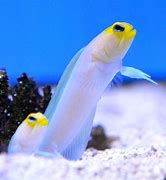
Yellowhead Jawfish
The Yellow-headed Jawfish (Opistognathus aurifrons) is a small fish species belonging to the family Opistognathidae. Here are some interesting facts about the Yellow-headed Jawfish:
Appearance: The Yellow-headed Jawfish has a relatively elongated body with a slightly compressed shape. It has a distinct yellow-colored head and a slender, elongated jaw. The body coloration can vary from pale to light brown or gray, with some individuals having faint vertical stripes or mottling. They have large, round eyes and a relatively large mouth.
Size: Yellow-headed Jawfish are relatively small in size. They typically grow to about 4-5 inches (10-13 cm) in length, with females often being slightly larger than males.
Distribution: Yellow-headed Jawfish are native to the Western Atlantic Ocean, primarily found in the Caribbean Sea. They are commonly encountered in the coastal waters of Florida, the Bahamas, and other Caribbean islands.
Habitat: These jawfish are typically found in sandy or rubble areas near coral reefs, seagrass beds, and rocky substrates. They are known for constructing burrows in the sandy bottoms, where they spend most of their time and retreat for safety. These burrows serve as their shelter and spawning sites.
Behavior: Yellow-headed Jawfish are known for their interesting behavior and unique mouthbrooding reproductive strategy. They are generally solitary and territorial, defending their burrows from other fish. They spend much of their time near the entrance of their burrows, occasionally venturing out to feed on small crustaceans and other small invertebrates.
Mouthbrooding Reproduction: One of the most fascinating aspects of Yellow-headed Jawfish is their reproductive behavior. After mating, the male collects the eggs in his mouth and incubates them until they hatch. During this period, the male will not eat and takes great care to protect the developing eggs and juveniles. Once the juveniles are ready to swim on their own, they are released from the male’s mouth.
Conservation Status: The conservation status of Yellow-headed Jawfish is not specifically assessed. However, as with many coral reef-associated species, they can be vulnerable to habitat degradation, overfishing, and other anthropogenic impacts. It’s important to protect their coral reef habitats and maintain sustainable fishing practices to ensure the long-term survival of these fascinating fish.